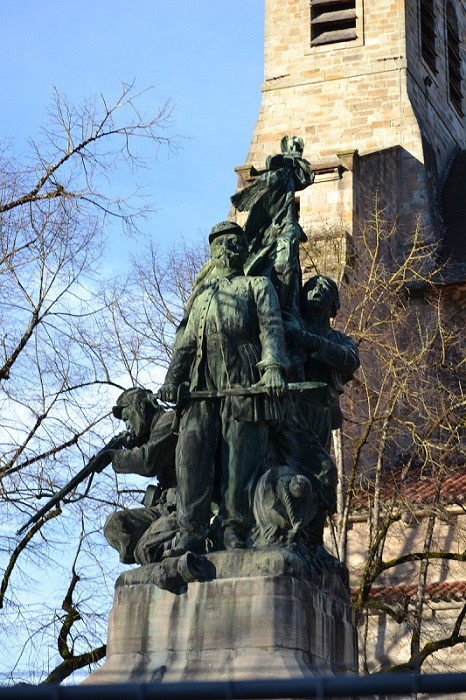This war memorial is dedicated to those who died in the War of 1870 [the Franco-Prussian War]. It was erected and revealed to the public on 7 July 1907, at a site donated by the commune of Figeac. The memorial was financed by a subsidy from the Lot département as well as a fundraising campaign initiated by the Société des Anciens Combattants [the Veterans’ Society]. The State granted the project an additional subsidy of 6,000 francs through the Ministry of Fine Arts. The monument features a group of figures and a bas-relief, both sculpted in bronze, on a pedestal of limestone. Beneath the figures there is a marble plaque that lists the names of those from the commune of Figeac who lost their lives in the War of 1870.
Click on the photos below to see them in larger format.
The memorial depicts the ‘glorious’ death of Captain Pierre Auguste Anglade (1835-1870)
It is also dedicated to the captain, himself a native of Figeac. He was the son of a wealthy merchant and a former pupil of the École Spéciale Impériale de Saint-Cyr [France’s foremost military academy]. At the outbreak of the War of 1870, Anglade was a lieutenant, having been awarded the 1859 Italian Commemorative Medal and the Sardinian Medal of Military Valour after he distinguished himself during the Italian Campaign. For the next six years he remained at the Limoges garrison, after which point it appears that boredom finally got the better of him as he requested to switch positions with another officer (which, incidentally, would mean a demotion) in order to join the 2nd Algerian Tirailleurs Regiment of Mostaganem(The Algerian Tirailleurs were part of France’s Army of Africa, and were nicknamed the ‘Turcos’. Tirailleurs translates as ‘skirmishers’). He perished alongside the men of this regiment (which had been integrated with the Army of the Rhine) during a bayonet charge that he himself rallied in a last stand against Bavarian soldiers at the Battle of Wörth on 6 August 1870. His promotion to the rank of Captain had been announced two days before, but he did not live to hear the news.
► Read an account of Anglade’s death (in French)(Article by Jean-Pierre Baux published in Le Casoar, a quarterly review of Saint-Cyr students and former students, n° 185, April 2007, published on quercy.net)
The monument in Figeac bears an inscription recalling his heroic acts: above the bas-relief, the statue reads, ‘MORT HÉROIQUE/DU CAPITAINE AUGUSTE ANGLADE/BATAILLE DE WOERTH/LE 6 AOUT 1870’ [THE HEROIC DEATH/OF CAPTAIN AUGUSTE ANGLADE/BATTLE OF WÖRTH/6 AUGUST, 1870]. The bas-relief immortalizes the bloody event of Captain Anglade’s last charge.
► Click here to see the mass grave in Wörth. It is marked with a cross, and dedicated to Pierre Auguste Anglade and his men (website in French). It is the final resting place of the captain, twenty of his men and five enemy soldiers. The affixed inscription reads: AUX/BRAVES TURCOS/ICI REPOSE MON FILS/P. AUGUSTE ANGLADE/CAPITAINE DE TURCOS/ MORT AU CHAMP/D’HONNEUR/LE 6 AOUT 1870/ À L’AGE/DE 34 ANS [TO/THE BRAVE TURCOS/HERE RESTS MY SON/P. AUGUSTE ANGLADE/CAPTAIN OF TURCOS/DIED ON FIELD/OF HONOUR/ON 6 AUGUST 1870/AT THE AGE/ OF 34 YEARS].
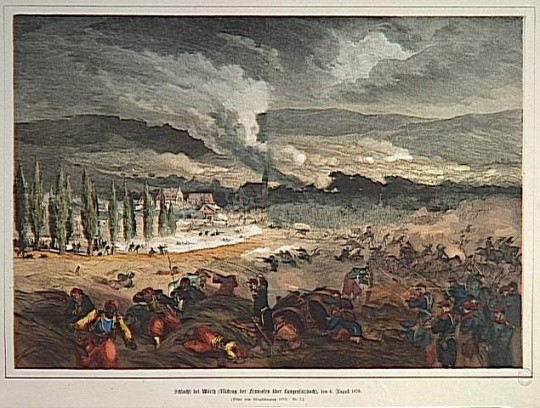
© RMN-Grand Palais – Agence Bulloz
The monument to the dead at Figeac is not dedicated to Anglade alone, but to all of the men from that commune who died in the conflict.
The ‘collective’ nature of the monument is highlighted in the frieze that surrounds the sculpture: ‘Glorification aux enfants de l’arrondissement morts pour LA PATRIE/1870-1871’ [Glory to the children of the district who died for LA PATRIE/1870-1871]
► See the names of the men from the commune of Figeac listed on the marble plaque.
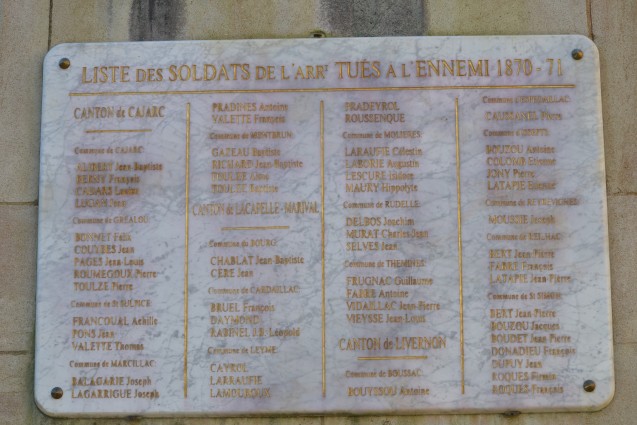
© Commune de Figeac. Photo: Stéphane Caray
To the right of the figure representing Captain Anglade, there is a statue of a member of the national Garde Mobile in firing position. This represents Albert Delpech, also from Figeac, who died after the fall of the Second French Empire when the provisional government called on the “Garde Mobile” to continue fighting the Prussian forces.
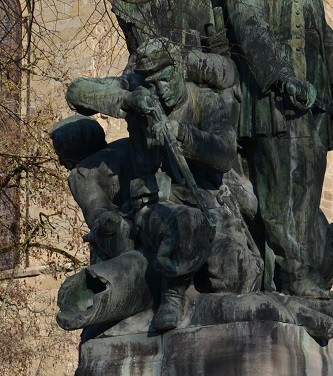
© Commune de Figeac. Photo: Stéphane Caray
The sculpture group also depicts a tirailleur with a firm grip on the flag. This figure represents Sergeant Abd el-Kadder ben Dekkish, who ensured that the flag did not fall into Bavarian hands. He is included to represent the men who fell beside Anglade.
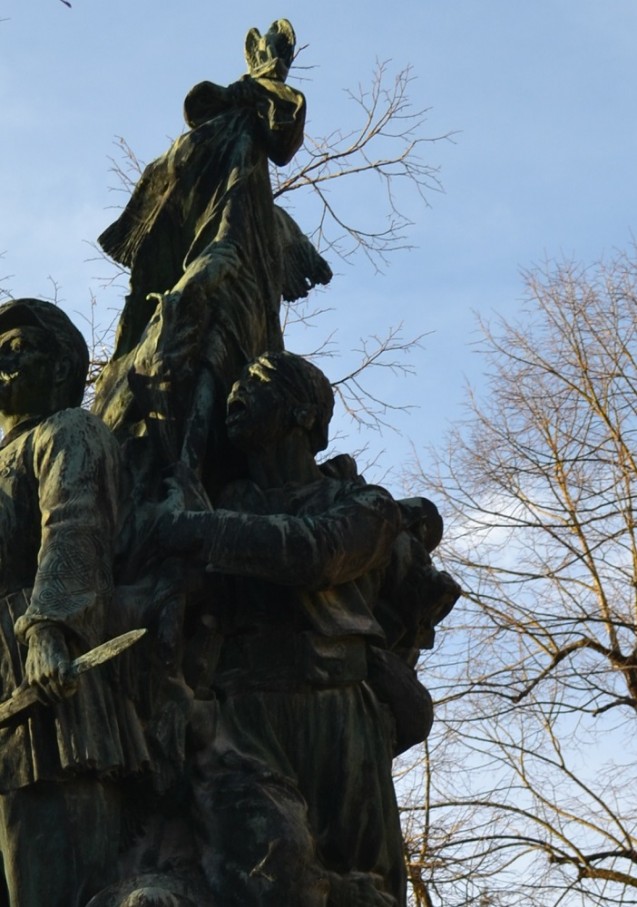
© Commune de Figeac. Photo: Stéphane Caray
The artilleryman (the only figure depicted at the moment of death) completes the sculpture group, and represents all soldiers from throughout the French Empire or Third Republic who died during the war.
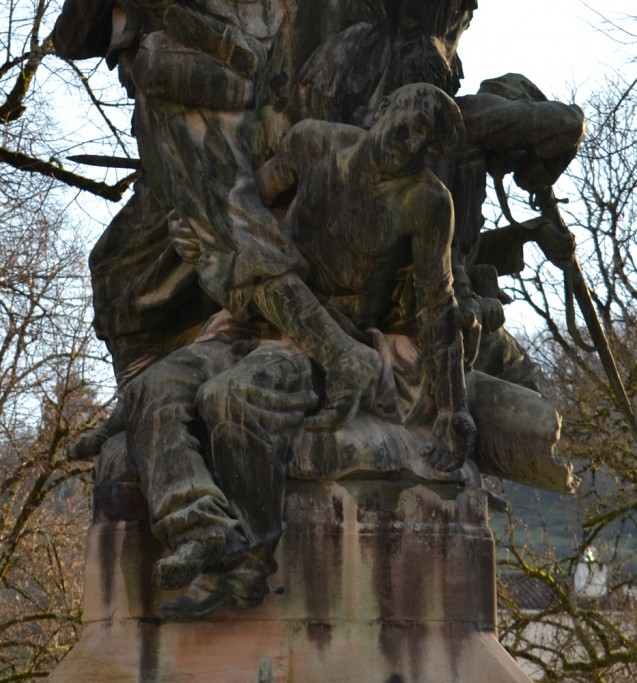
The bas-relief shows the names of the sculptor Auguste Seysses (1862-1946) and the founder Joseph Malesset.
The artists who were inspired by the War of 1870.
Joseph Malesset was an entrepreneur and public figure of the Belle Époque who made his fortune in the production of aquaselzer appliances. He was a distinguished individual in the public sphere and was made an officer of the Légion d’Honneur in 1906 as well as an officer of the Ordre des Palmes Académiques [‘Order of Academic Palms’: a national order of the French Republic awarded to distinguished academics, and for valuable service to universities, education and science] and of the Order of Agricultural Merit. He served as a judge at the Tribunal de Commerce [Commercial Court] of the Seine, an adviser on foreign trade, and a member of the Conseil Supérieur des Colonies [The Grand Council of the Colonies]. He made investments in both industrial and artistic foundries, and his involvement in the creation of the monument reveals his patriotic sentiment.
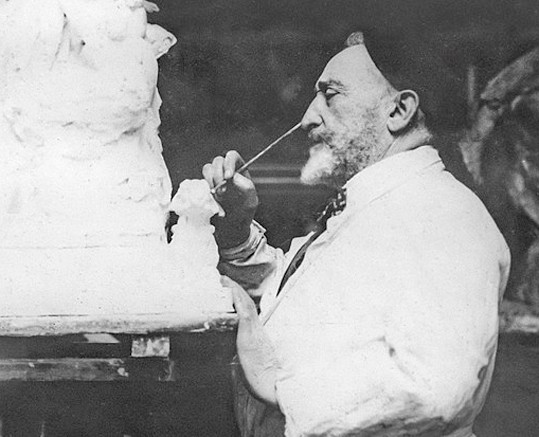
The monument was sculpted by Auguste Seysses, a sculptor born in Toulouse. He was a pupil of Alexandre Falguière – who had himself been a pupil of Albert-Ernest Carrier-Belleuse and François Jouffroy: two great sculptors of the Second Empire – and he is known to have collaborated with Alphonse Mucha. His career reached a turning point during the Universal Exhibition of 1900, where his sculpture Retour [The Return] received a lot of attention. His plaster cast of the Figeac war memorial was exhibited at the Salon de la Société des Artistes Français [the French Society of Artists’ annual exhibition] in 1906 where it was met with great success.
At the outbreak of war in 1870, Seysses was eight years old and, like his master Falguière, he was greatly affected by the conflict. In 1874 Falguière carved his allegory La Suisse accueille l’armée française on the theme of the war, recalling the episode when the Army of the Rhine was interned in Switzerland (after it had laid down arms and was waiting for its fate to be determined by negotiations between the Prussians and the French). Seysses also expressed his devotion to those who had died for France during the First World War by sculpting a war memorial to be erected in Toulouse, Place des Minimes. ► Other famous sculptures by Seysses
At the end of the Franco-Prussian War, this artistic momentum carried a sentiment of popular patriotism inspired by the glorious struggle of 1870-1871 the length and breadth of the entire country. The appearance of local and spontaneously erected war memorials like the one at Figeac, supported by the state, are some of the most obvious testimonies to this artistic expression of patriotism.
The French Third Republic sustained this nation-wide patriotic fervour by overseeing the public unveilings of these war memorials, as well as commemorative events, and by maintaining military cemeteries. Mass graves were replaced by individual graves for the war dead after a law was passed on 1873.
The 1870 monument itself is sited in a town square that is in fact the historical nucleus of the town. Here was once the cloister of a mediaeval abbey (destroyed by the Revolution), of which the church of Saint-Sauveur is the only remaining part. The monastic grounds were renamed ‘Place de la Raison’ (‘Reason Square’, as opposed to belief, God bless the French Revolution!), the name it still bears. And there was also a previous ‘Napoleonic’ monument on the site. In 1833, another famous son of Figeac was honoured, namely Jean-François Champollion (1790-1832), the father of Egyptology, much of whose research work was provided by Bonaparte’s Egyptian Campaign of 1798-1799.
Marie de Bruchard, April 2020 (translation JR with PH)
Further reading
►(French) Les racines d’une commémoration : les fêtes de la Revanche et les inaugurations de monuments aux morts de 1870 en France (1871-1914) [The origins of a commemoration: Revenge feasts and Inaugurations of War memorials of 1870 in France, 1871-1914] Rémi Dalisson, Revue historique des Armées [Armed Forces Historical Review] n°274, 2014 (Thanks to M. Michel Kerautret for bringing this source to our attention)
► (French) Témoins d’une guerre oubliée : les monuments commémoratifs de 1870-71 en Haute-Normandie [Witnesses of a forgotten war: the war memorials of 1870-71 in Upper Normandy], Jean-Pierre Chaline, Études Normandes [Norman Studies] Year 2009 58-1
► (French) Double peine des monuments aux morts disparus [The double fate of war memorials that have disappeared], Jean-François Lecaillon, Blog Mémoire d’Histoire Mémoire d’Histoire, February 2018
► Wikipedia article with a list of monuments to the War of 1870
Extra sources
►(French) The monument to those who died in the War of 1870, at Figeac, on the Musée d’Orsay website: À nos grands hommes [To our great men]
► (French) War memorials in France – Belgium – Other countries, census database created by the Laboratoire UMR CNRS IRHiS Institut de Recherches Historiques du Septentrion at the University of Lille
► Short biography (in French) of Auguste Seysses on the site nelle-buscot.com
► Short biography of Joseph Malesset on the site of The Galerie Heim


